

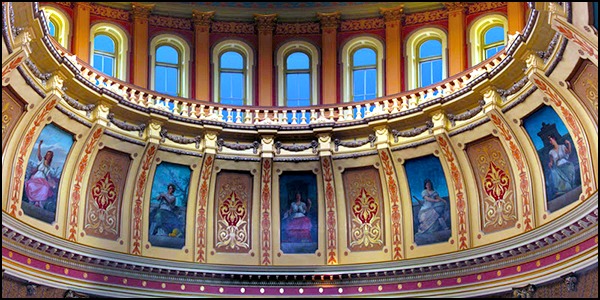
The Michigan State Capitol has been acclaimed as an outstanding example of governmental architecture from America’s late nineteenth-century Gilded Age. Today, it is a registered National Historic Landmark. Built in the style of the Federal Capitol in Washington, D.C, the domed building launched a larger trend in statehouse architecture across post-Civil War America. Subsequently, Michigan Capitol architect Elijah E. Myers went on to design both the Texas and Colorado Capitol buildings.

Every year tens of thousands of students visit the Michigan Capitol in order to tour the legislative chambers of both the Michigan Senate and the Michigan House of Representatives, plus other public rooms. Students especially enjoy laying down on the glass floor of the Capitol rotunda, looking up to the oculus or eye of the dome more than a hundred feet above. Also in sight are eight monumental muses which ring the upper reaches of the dome. Painted on canvas, the muses were installed in the Capitol dome in September 1886, the same month that the Statue of Liberty was unveiled in the New York City harbor. Originating in Greek and Roman mythology, muses like the “painted ladies” of the Michigan Capitol dome or “Lady Liberty” in New York City’s harbor are female figures said to inspire the finest ideas and creativity of humankind. The more familiar word “museum” comes from “muse.”
For many years the muses of the Michigan State Capitol were shrouded in mystery. No one knew for sure who had painted the muses or what they represented. Even more amazing was the fact that the State of Michigan kept no records about the source and meaning of the eight muses. All this began to change in the late 1980s and early 1990s when the entire Michigan State Capitol building underwent a renovation meant to restore its original nineteenth-century splendor. Cleaning and repair of the muses by a conservation team from the Detroit Institute of Arts revealed that many of the muses bore an artist’s mark, almost resembling a stick figure. On the basis of its up-close examination, the DIA restoration team was able to definitively rule out the possibility that the muses were painted by Michigan artist Lewis Ives, who had completed art work elsewhere in the Capitol building. But the artist’s mark remained indecipherable and puzzling.
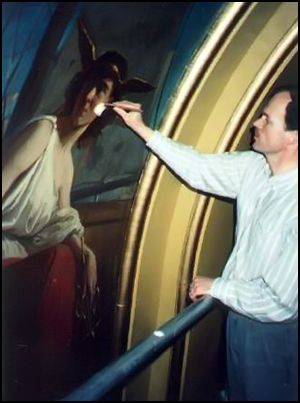
Ultimately, it was the serendipitous visit of a Metro Detroit resident looking for the on-site work of an Italian artist that began to pierce the greatest mystery. The Capitol visitor, the Reverend Geoffrey G. Drutchas, had previously uncovered a 1905 arts magazine crediting Boston-based artist Tommaso Juglaris with a major commission at the Michigan Capitol. Already familiar with Juglaris’s work in Boston and elsewhere, he immediately recognized Juglaris’s painterly style and technique in the Michigan Capitol muses. Working collaboratively with Michigan State Capitol historian Kerry Chartkoff, Drutchas was able to successfully authenticate Juglaris as the source of the muses. The artist’s mark turned out to be a T-J monogram, incorporating the initials of Juglaris’s first and last names. An identical monogram was located on a painting of a young woman owned by the Famija Moncaliersa, a cultural heritage organization in the artist’s hometown of Moncalieri, Italy. Variations of the monogram also appear on other Juglaris works. Later, a preliminary sketch of four of the Michigan Capitol muses was discovered among the artist’s surviving papers in northern Italy. With one mystery cleared up two others still remained: What exactly did the muses mean or represent? And why was Juglaris so completely forgotten?
It turned out that unlocking the meaning of the muses was easier than first imagined. In fact, it became increasingly clear that each muse in the Michigan State Capitol was intended to symbolize a different field of endeavor important to the progress of the State of Michigan. In creating his muses Juglaris was guided by an iconography or language of symbols that has been widely used by artists since the European Renaissance, if not earlier. Consulting a seventeenth-century text by the Italian iconographer Cesar Ripa, entitled Iconologia, Drutchas and Chartkoff were able to successfully interpret all eight muses. They symbolize Agriculture, Commerce, Industry, Science, Art and Architecture, Law and Government, Philosophy, and Education.
A close comparison between the muses that actually appear in the Michigan rotunda and Juglaris’ original sketch for four of them suggests that he modified one muse initially tagged as “Justice” in order to transform it into a muse representing philosophy, signified by the tell-tale Pi sign that appears on her tablet. Since law and government were already represented by a muse, another allegorical figure denoting justice may have struck either Juglaris or his Michigan patrons as redundant.
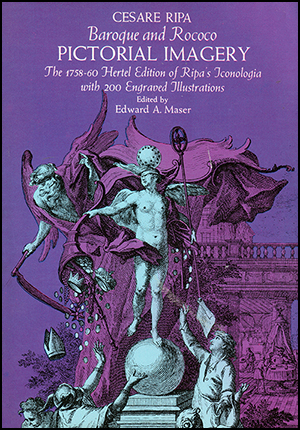
Further research has also clarified why Juglaris was forgotten in Michigan as the source of the muses. On the basis of Juglaris’s own memoirs, it appears that all of the muses were painted in his Boston studio and shipped to Michigan. The subsequent installation of the muses in the Michigan State Capitol came on the heels of intense labor agitation and strife as workers across the United States demanded higher pay and a shortened work day. In a year still remembered by labor historians as “The Great Upheaval,” there were widespread fears about the patriotism and political loyalty of foreign-born workers and immigrants like Juglaris. In late winter 1887 the Michigan Legislature passed a law banning those who were not American citizens from working on public buildings. Since Juglaris remained a citizen of his native Italy, there was, politically speaking, never an opportune time to acknowledge him as Michigan’s Capitol artist. In the words of Michigan Capitol historian Kerry Chartkoff, Juglaris’s identity as artist, designated by an obscure monogram on works that could only be viewed from a distance, was “buried in plain sight.”
Installing the muses finished in Juglaris’s Boston studio, the muses were shipped as rolled canvases to Lansing. In September 1886, they were installed in eight of sixteen framed niches, shallowly recessed and curved, which rim the lowest reaches of a rotunda dome. Interspersed between Juglaris’s murals in the remaining framed niches are brown and gold decorative panels with elaborate decorative motifs.
For reasons not exactly known, Juglaris’s murals did not fit the full length of their own recessed niches. Although a measurement mistake may have been made, it is also possible that the limits of late nineteenth-century loom technology prevented Juglaris from securing full-sized canvases. To compensate in each case, a separate piece of canvas had to be affixed, edge-to-edge, below Juglaris’s painted work to fill the niche space. Painted a dark chocolate brown, the additional canvas creates a platform effect, adding uniformity to all eight muse without noticeably distracting from them.
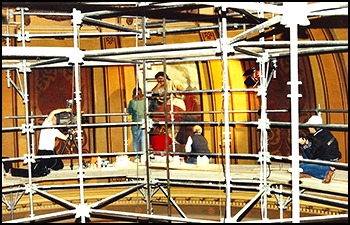
Presiding over the rotunda from their supernal heights, Juglaris’s muses are essentially vertical works set against a strong horizontal plane. Each allegorical figure sits along a low-rise wall or ledge that divides the lower and upper halves of the canvas. Six of the muses are posed with outstretched arms and a rightward turn of the head and upper torso, intimating movements for otherwise static figures. The usefulness of this positioning is underscored by the two remaining muses who, unblinking, gaze almost straight ahead without so readily enticing the engagement of the viewer.
Juglaris dressed all of his muses in loose-fitting, high-waisted white robes, each subtly reflecting the day- or night-time light of the iconographical scene. The upper bodice of the Muse of Commerce, for instance, almost fades out against the light flesh tones of her exposed neck and left shoulder, suggesting the bright sun of early midmorning. In contrast, the gown for the Muse of Law, who sits vigilantly at night, is a subdued off-white. Meanwhile, the richly colored cloaks of olive, gold, red, green, peach, or blue that drape the muss from lap to feet appear almost carelessly arranged but are not casually executed at all: the folds and creases of the flowing fabric, simultaneously suggesting a play of light and shadow, add dimension and depth to allegorical portraits that would otherwise be much visually flatter.
Consonant with these relatively spare backgrounds, Juglaris avoids cluttering the fore- or middle-ground of his murals with whatever accoutrements he thinks necessary to further identify his muses. Rendered simply without any fussiness, iconographic symbols—for example, a sword and scales for the Muse of Law or a caduceus and globe for the Muse of Commerce—are used to balance each composition, keeping it symmetrical. In most of the murals, especially where a diadem, cap, or headdress appears, the iconographic elements subtly encircle the massed figure. In employing symbols, Juglaris follows the iconographical conventions standardized by Cesare Ripa and others as early as the Baroque era.
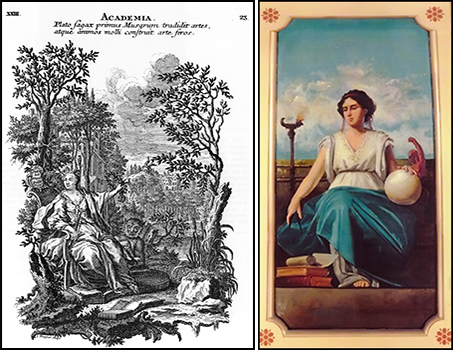
Despite the fact that each muse holds instruments in her hands, fitting her for a particular discipline, her focus remains completely interior—a sense especially ratified where she averts her gaze. The painted backgrounds in all eight Juglaris muses further reinforce the contemplative, if not brooding, nature of the muses. Five of them are depicted with a cloud-filled or star-lit sky, implying mindsets that are ethereally disposed. The other three muses have for a backdrop either unfurled sails or the dark silhouette of a throne, betokening concerns that also rise above the mundane.
The freshness and individuality of the muses were undoubtedly enhanced by Juglaris’s use of live models. In look, pose, and gesture, none of these allegorical figures have the theatrical allure of Paul Baudry’s more renowned muses at the Palais Garnier in Paris, completed in 1879, nor the almost coquettish prettiness of many of the female figures executed by various native American artists for mural commissions at the Chicago World Columbian Exposition and the Library of Congress in the 1890s. Instead, without being buxom, Juglaris’s Michigan Capitol muses possess a full-figured stolidity compatible with women who are to represent weighty and solemn endeavors in civilized human affairs. Overall, the appeal of the Juglaris murals seems well-suited to Michigan residents celebrating fifty years of statehood and determined to set aside their recent rustic past and become part of a more sophisticated, cosmopolitan culture.